After learning about the primary producers (vegetation) and their primary consumers (herbivores), we moved on to discuss those animals higher up the food chain. Carnivores play crucial roles in ecological systems – they keep prey species’ populations in check, allowing for natural regenerating of grazed areas on the landscape. They also cull sick animals to control parasites and disease. Losing carnivorous species can have drastic impacts on environments.
A disproportionate amount of research focuses on large, iconic carnivorous predators, such as the African lion. In contrast, scientists still know very little about the ecology of small carnivores (clocking in around 15kg or less). Yet small carnivores impact ecological systems just as much, if not more so than the large carnivorous species that are so well known. In fact, as large carnivorous predatory species become endangered, small carnivores take on their former roles in these systems.
Dr. Adam Ferguson is another researcher here at Mpala who kindly shared his experience in and knowledge of small carnivore research with the TBI students. Dr. Ferguson uses his small carnivore expertise here at Mpala by studying several different species. The data collected from these studies will help us understand more about their specific ecological roles here at Mpala, and about small carnivore ecology more broadly.
The students and I were very fortunate to take part in this research by helping Dr. Ferguson set up human, baited traps around Mpala. The traps were set in the hopes of catching any nocturnal small carnivore species. We were in luck and successfully trapped a common genet (Genetta genetta). Genets likely share a common ancestor with the sister families of hyenas and mongooses.
Dr. Ferguson, together with Dedan Ngatia developed a safe, humane and efficient method for collection scientific samples from the animal. All of this data collection occurs while the animal is anaesthetized, so they don’t feel and pain or fear. Additionally, a soft cloth mask is placed over the animal’s eyes and ears to block out any startling movements or sounds. Each animal is provided with an ear tag for identification.
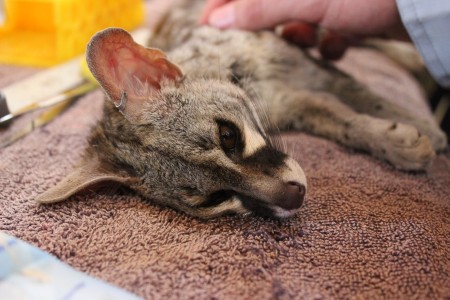
Every captured animal is given an ear tag so that Dr. Ferguson and his team knows when they are new individuals or re-captured.
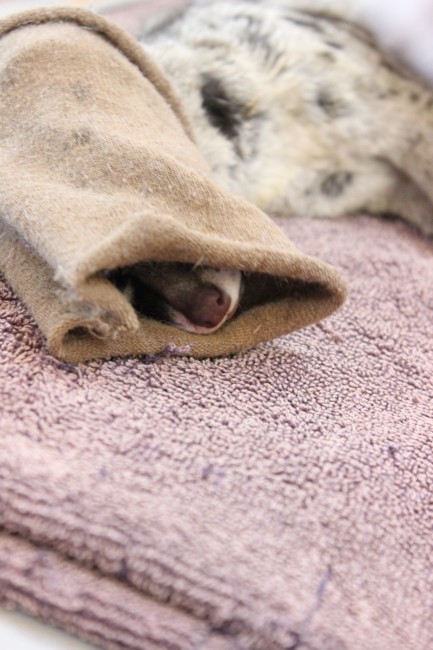
The sleeping genet won’t be disturbed with this gentle mask placed over its ears and eyes.
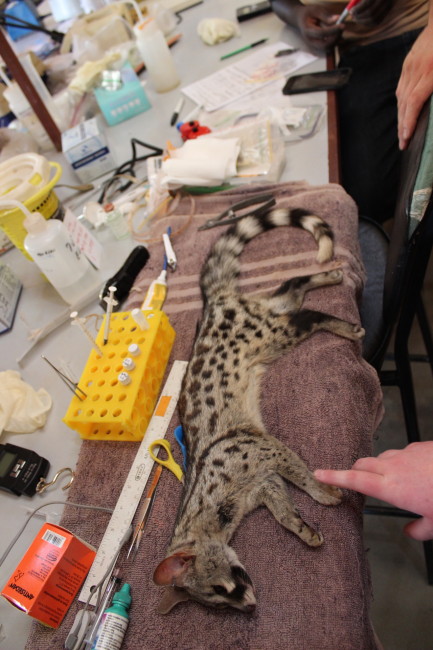
The common genet (Genetta genetta) is a small carnivore here at Mpala. This is a young (about 1 year) female, weighing under 1kg. She feeds on invertebrates, such as beetles, and is nocturnal.
Dr. Ferguson and Mr. Ngatia record basic body (weight and size) measurements to monitor the growth of every animal that they capture. In addition to these, health measures are collected, including breath and heart rate, temperature, and blood oxygen. This way, the researchers can monitor the health of each individual animal.
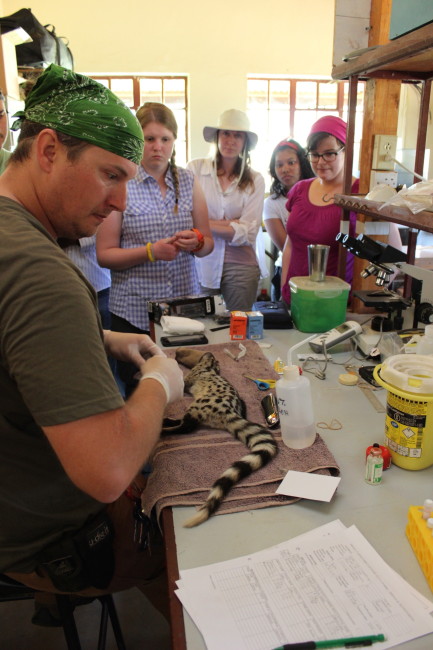
Students Maddie, Milena and Adriadne watch Dr. Ferguson as he records the breathing rate of the genet about every 10 to 15 minutes to monitor her health and the effectiveness of the anesthesia.
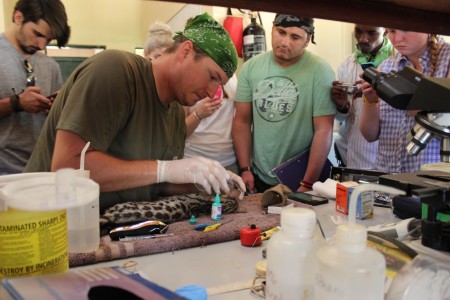
The most important data for this current research program is that containing information about the animals’ interactions with various parasites and viruses. Blood and fecal samples provide this information. Parasites that the animal contracts through their diet are found, counted and identified in the fecal samples, while and contracted viruses are picked up in the blood sample. Finally, the genet is checked for fleas and ticks that will later be identified and screened for any parasites and viruses.
Mr. Ngitia is part of an important project with Dr. Ferguson investigating the impact of rabies on humans, domestic and wild animals in the Laikipia region (Small Carnivore Research and Parasite Study). Many people die every year from the rabies virus, and Mr. Ngitia’s team works with local communities to provide education about the virus, its facts and its prevention, and to provide vaccines for dogs within these communities (pets, herding and/or security dogs).
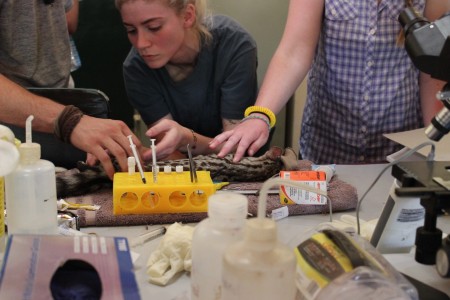
After the samples were collected from the animal, the students were able to pet the genet and get a closer look.
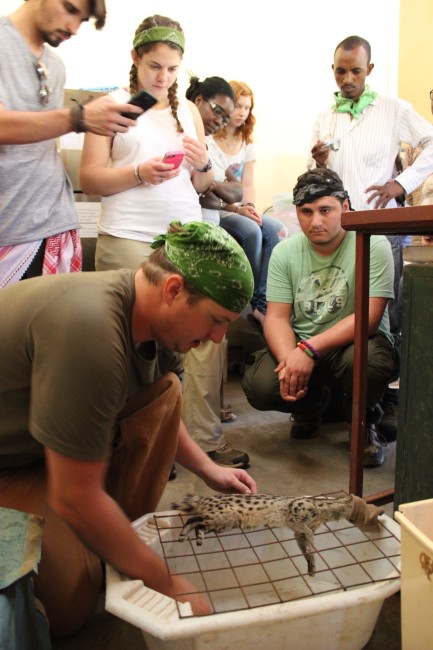
Evan, Jen, Max and Yemane watch as Dr. Ferguson washes fleas off of the genet. These flees will later be collected for analysis and counts.
Experience-based learning continued this week with a special guest lecture by Steven Ekwanga, who together with Laurence Frank and their team on the Laikipia Predator Project, work toward conserving dwindling lion populations in the Laikipia region.
Lions are endangered in many places in eastern Africa, and conservation efforts are crucial for their survival. Aside from sport hunting in the past, lion populations are at risk of conflict with local herding communities, particularly in the Laikipia region. As I mentioned in the previous post, these communities largely depend on the health and well-being of their livestock for their livelihoods. Any threat to their livestock is a threat to the quality of their lives. This is an extremely important issue. We want to protect the endangered lions, but we don’t want to negatively impact the local communities’ economies. In the recent past, ranchers have shot or poisoned lions who have attacked their herds. This results in a high number of lion deaths within the region, which has threatened the viability of these populations. Mr. Ekwanga and his team place radio signal and gps collars on lions within the region, tracking their numbers and movements.
We were all treated to a special trip out to track the lions at Mpala. Using radio signals, Mr. Ekwanga located nearby lions and led a convoy of students in vehicles out for a sighting. The students and I were certainly spoiled – we spotted three adult males, two adult females, and a young (2.5 year old) male. I’m sure that this was an experience we will all never forget.
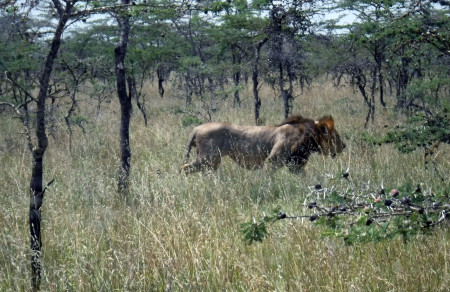
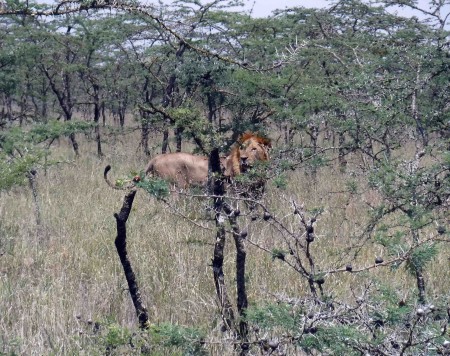
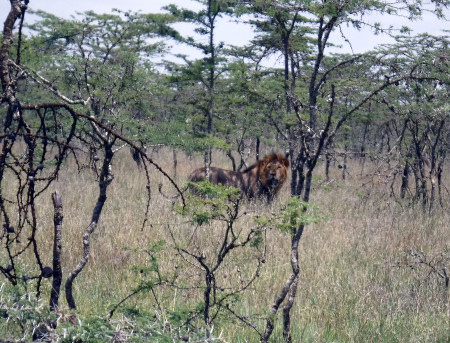
Several lucky students had the opportunity to follow three adult brother lions in the black cotton environment at Mpala.
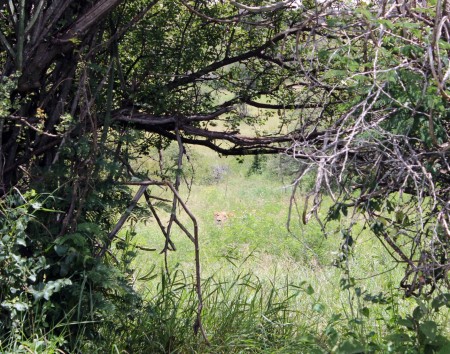
A female lion peeks at us through the bushes – don’t worry, we were safely inside the vehicle!
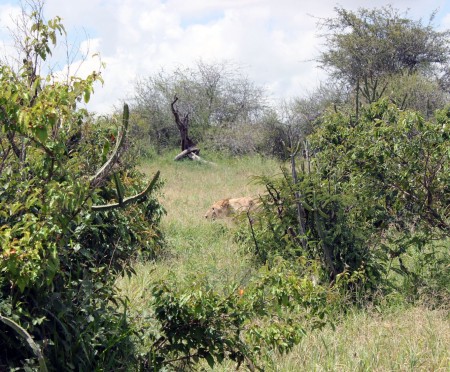
A 2.5-year-old male sneaks from bush to bush, hiding from us as we followed him inside the vehicle. It’s great to know there is a relatively new juvenile lion at Mpala.
Stay tuned for another post about the Great Grevy Zebra Rally on Jan.30-31 – coming soon!





